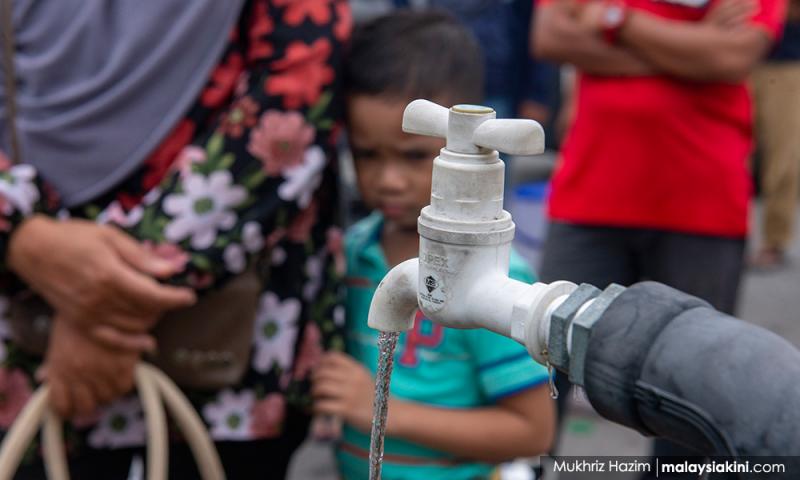LETTER | Increase standby spare water capacity to prevent disruptions
LETTER | Selangor residents are, unfortunately, too familiar with water cuts. Since June 2019, there have been at least 15 water disruptions, mostly due to contamination of raw water source resulting in the closure of water treatment plants (WTP).
Many have resorted to installing additional water tanks in their homes in the hope that the additional storage capacity in their homes will help them tide over the supply outage.
Many other consumers who cannot afford these additional storage tanks are left to cope with the meagre supply from the Pengurusan Air Selangor’s (AIS) mobile tankers, which are usually mobilised long after the supply dries up.
Now, if we can scale up this simple approach by having an independent source as standby spare capacity, we could have an immediate solution to potential water supply disruptions whilst the authorities continue to battle with water polluters - a problem, everyone realises, that is going to take some time to resolve.
Standby spare capacity, in this context, is defined as the quantity of potable water from independent sources that can be distributed to consumers in the event any WTP shuts down for whatever reason – thus ensuring an uninterrupted water supply to end-users. The source(s) of this Standby Spare Capacity can be turned off once the WTP(s) restart their normal operations.
Do we have spare capacity of treated water?
The Environment and Water Ministry (Kasa) recently reported that the total spare capacity in Selangor is only 1.5percent. Once the Langat 2 WTP comes online (projected in 2023), Selangor will have a spare capacity of 10 percent.
But, given the extreme susceptibility of the off-river/river-based WTPs to pollution, is this spare capacity independent of the current river-based sources, and is this spare capacity of 10 percent enough to eliminate the frequent water supply outages?
There is a quantified and viable alternative to increase the standby spare capacity – groundwater. And we do not have to wait till the Langat 2 WTP comes online in 2023 as groundwater can be tapped with minimal effort and in very short order.
[For the record, the state government had introduced the HORAS 600 (or Hybrid Off River Augmentation System 600) alternate raw water supply system to increase spare capacity. Costing over RM700 million, the HORAS 600 was declared open on Nov 27, 2019 (the project implementation started in July 2015) where the Selangor menteri besar even proclaimed that water outages will be a rare occurrence in Selangor. Sadly, we know that is not the case.]

The case for groundwater
So why are the planners not looking at groundwater as a resource to increase spare capacity?
Luas already manages all groundwater extractions. Luas charges RM150/annum licence and RM0.01/cubic metre of water extracted measured via a water metre installed at the outlet of the groundwater borewell. So it is not because they do not know of its availability.
How do we use groundwater to significantly increase the standby spare capacity? The first option is to establish borewells farms with sufficient yield, in the vicinity of WTPs which are particularly prone to pollution caused outages, to meet supply demands in the event the WTPs need to be closed to manage the pollution.
Alternatively, borewells can be established near to the principal pumping main storage facilities to fulfil the same objectives.
An urgent feasibility study needs to be undertaken to study the viable extraction of good quality groundwater of sufficient yield to meet the supply requirements of any specific WTP, keeping in mind that the above two options may be melded to meet supply requirements.
A third option could be a more distributed system involving the siting of borewell farms to be managed jointly by the local authorities and AIS. This option will need to be a fallback option when the melding of Options 1 and 2 still does not meet the requirements of this standby spare capacity.
I humbly urge the state government to form a task force consisting of industry experts to look into how best to implement this standby spare capacity in the shortest timeframe possible.
Read more here.
BALACHANDRAN NAICKER is a registered professional Civil Engineer and chairperson of Kawasan Rukun Tetangga SS17, Subang Jaya. He is also the secretary to the Majlis Persatuan Penduduk (MPP) of Zone 1 of Majlis Bandaraya Subang Jaya.
The views expressed here are those of the author/contributor and do not necessarily represent the views of Malaysiakini.
RM12.50 / month
- Unlimited access to award-winning journalism
- Comment and share your opinions on all our articles
- Gift interesting stories to your friends
- Tax deductable
